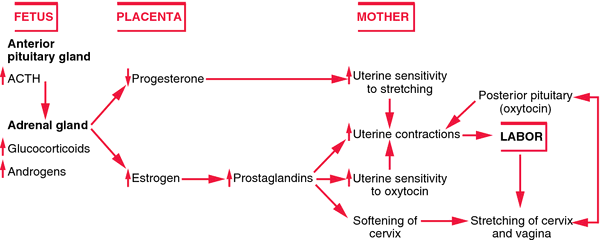Cause of Onset of Labour
Labour- is a physiological process during which products of conception are expelled outside the uterus.
Cause of Onset of Labour-
No one knows exactly what triggers the onset of labor. Some researchers think that hormonal changes within the fetus cause the placenta to produce increased levels of a substance known as corticotrophin-releasing hormone.
Uterine distension-
Stretching effect on the myometrium by the growing fetus and liquor amnii can explain the onset of labor at least in twins or polyhydramnios. Uterine stretch increases gap junction proteins, receptors for oxytocin and specific contraction associated proteins.
Fetoplacental contribution-
Cascade of events activate fetal hypothalamic-pituitary-adrenal axis prior to onset of labor → increased CRH → increased release of ACTH → fetal adrenals cortisol secretion → accelerated production of estrogen and prostaglandins from the placenta → increased
Estrogen-The probable mechanisms are-
- Increases the release of oxytocin from maternal pituitary.
- Promotes the synthesis of myometrial receptors for oxytocin (by 100–200 folds), prostaglandins and increase in gap junctions in myometrial cells.
- Accelerates lysosomal disintegration in the decidual and amnion cells resulting in increased prostaglandin (PGF2α)
- Synthesis. — Stimulates the synthesis of myometrial contractile protein—actomyosin through cAMP.
- Increases the excitability of the myometrial cell membranes.

Progesterone-
Increased fetal production of dehydroepiandrosterone sulfate and cortisol inhibits the conversion of fetal pregnenolone to progesterone. Progesterone levels therefore fall before labor. It is the alteration in the estrogen, progesterone ratio rather than the fall in the absolute concentration of progesterone, which is linked with prostaglandin synthesis.
Prostaglandins-
The major sites of synthesis of prostaglandins are—amnion, chorion, decidual cells and myometrium. Synthesis is triggered by—rise in estrogen level, glucocorticoids, mechanical stretching in late pregnancy, increase in cytokines ,infection, vaginal examination, and separation or rupture of the membranes. Prostaglandins enhance gap junction formation.
Biochemical Mechanisms Involved in the Synthesis of Prostaglandins-
Phospholipase A2 in the lysosomes of the fetal membranes near term → esterified arachidonic acid → formation of free arachidonic acid → synthesis of prostaglandins through prostaglandin synthetase. Prostaglandins (E2 and F2α) diffuse in the myometrium → act directly at the sarcoplasmic reticulum → inhibit intracellular cAMP generation → increase local free calcium ions → uterine contraction. Once the arachidonic acid cascade is initiated, prostaglandins themselves will activate lysosomal enzyme systems. The prostaglandin synthesis reaches a peak during the birth of placenta probably contributing to its expulsion and to the control of postpartum hemorrhage.
Oxytocin and myometrial oxytocin receptors-
- Large number of oxytocin receptors are present in the fundus compared to the lower segment and the cervix.
- Receptor number increases during pregnancy reaching maximum during labor.
- Receptor sensitivity increases during labor.
- Oxytocin stimulate synthesis and release of PGs (E2 and F2α) from amnion and decidua.
Neurological factor-
- Estrogen causes α receptors and progesterone β receptors to function
- α receptors of postganglionic nerve fibers in and around cervix, and the lower part of the uterus initiate contraction